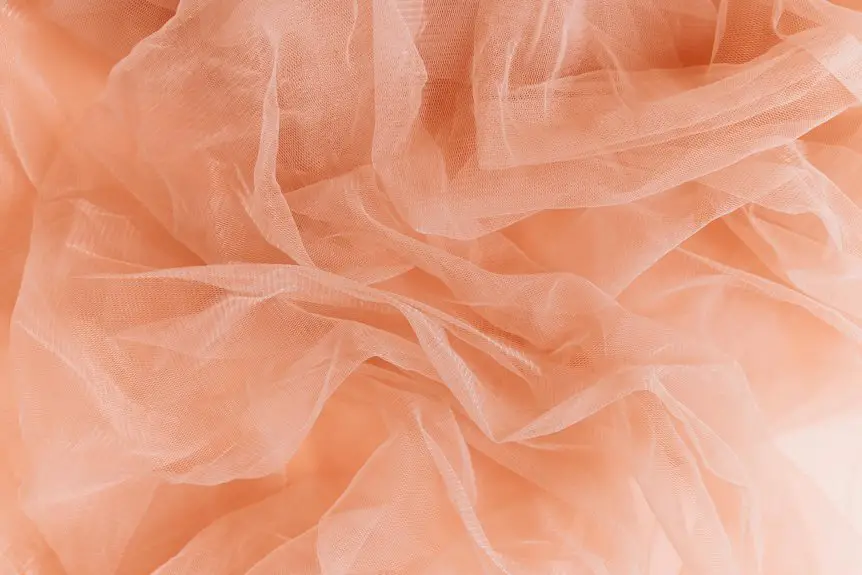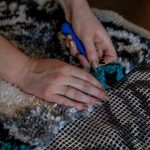You’ll find gauze fabric by the yard comes in various types to fit your needs. Cotton gauze offers softness and breathability, while cheesecloth is lightweight and versatile for crafts or cooking. Medical gauze focuses on sterility and absorbency, perfect for wound care. Double gauze provides layered comfort, and polyester gauze stands out for durability and easy care. Depending on your project, you’ll want to evaluate factors like texture and maintenance—there’s plenty more to explore about these fabrics.
Table of Contents
Key Takeaways
- Gauze fabric is a lightweight, breathable material used in medical, fashion, and home décor applications with various textures and durability.
- Cotton gauze is soft, hypoallergenic, eco-friendly, and ideal for sensitive skin and warm weather clothing.
- Cheesecloth gauze is loosely woven cotton, perfect for culinary, medical, and crafting uses due to its open weave and versatility.
- Medical gauze is sterile, highly absorbent cotton fabric designed for wound care, promoting healing and infection prevention.
- Specialty gauzes include double gauze for durability, silk gauze for luxury, and polyester gauze for strength and easy maintenance.
What Is Gauze Fabric?
Gauze fabric is a lightweight, loosely woven material known for its breathability and sheer texture. When you handle gauze, you’ll notice its open weave, which allows air to flow easily, making it perfect for warm weather or layering.
Gauze fabric’s open weave offers breathability and lightness, ideal for warm weather and layering.
This fabric’s structure creates a soft, delicate feel while maintaining strength despite its lightness. You’ll find gauze used in various applications, from medical bandages to fashion and home décor, thanks to its versatility.
Its transparency and texture add a unique aesthetic, whether you’re crafting garments or curtains. If you’re looking for a fabric that combines lightness with durability and a distinctive look, gauze fabric fits the bill without weighing you down.
It’s a smart choice for projects needing both function and subtle style.
Cotton Gauze Fabric: Softness and Breathability
You’ll appreciate cotton gauze fabric for its natural fibers that feel gentle on your skin.
Its softness makes it perfect if you have sensitive skin or allergies.
Plus, the breathable weave keeps you comfortable all day long.
Natural Fiber Benefits
Because natural fibers like cotton offer unmatched softness and breathability, they make an ideal choice for gauze fabric. When you choose natural fibers, you’re opting for comfort and practicality.
Cotton gauze fabric allows air to flow freely, keeping you cool and comfortable in warm weather. Plus, it naturally absorbs moisture, helping you stay dry throughout the day. You’ll also appreciate how durable natural fibers are, standing up to repeated washes without losing their softness or structure.
Here are some benefits you’ll enjoy with natural fiber gauze fabric:
- Eco-friendly and biodegradable, reducing environmental impact
- Hypoallergenic properties, minimizing irritation risks
- Excellent moisture-wicking, keeping skin dry and comfortable
Choosing natural fibers means you get a fabric that feels good and performs well.
Ideal for Sensitive Skin
If your skin tends to react easily, cotton gauze fabric offers a gentle touch that helps prevent irritation.
You’ll appreciate its natural softness and breathability, which allow air to circulate freely, keeping your skin cool and dry. Unlike synthetic materials, cotton gauze is hypoallergenic, reducing the risk of redness or itching.
When you choose cotton gauze by the yard, you get a lightweight fabric that feels comfortable against sensitive skin, making it perfect for baby clothes, scarves, or summer garments.
Plus, its loose weave guarantees moisture evaporates quickly, preventing discomfort.
Whether you’re sewing for yourself or someone with delicate skin, cotton gauze provides a soothing option that combines durability with comfort, making it an ideal fabric choice.
Cheesecloth Gauze: Lightweight and Versatile
You’ll find cheesecloth gauze made from loosely woven cotton, making it lightweight and breathable.
This open weave gives you flexibility for tasks like straining, wrapping, or crafting.
Whether you’re in the kitchen or working on a project, cheesecloth gauze adapts to many uses effortlessly.
Material and Weave
When selecting gauze fabric, understanding the material and weave is essential, especially with cheesecloth gauze, known for its lightweight and versatile nature.
Cheesecloth typically uses cotton fibers, giving it breathability and softness that you’ll appreciate in various projects. Its open weave structure creates a loose, mesh-like texture that allows air and light to pass through easily.
This weave impacts durability and flexibility, making cheesecloth both sturdy and pliable.
Here’s what sets cheesecloth gauze apart:
- Made from 100% cotton for natural comfort
- Features a plain, leno, or basket weave for different densities
- Offers various thread counts, affecting texture and transparency
Common Uses
Cheesecloth gauze serves many purposes thanks to its lightweight and breathable nature. You can use it for cooking, like straining liquids or wrapping herbs for flavor infusion. It’s also great for crafts, cleaning, and even medical applications due to its softness and absorbency. Whether you’re in the kitchen or tackling DIY projects, cheesecloth offers versatility that adapts to your needs.
| Use Case | Description |
|---|---|
| Culinary | Strain broths, bundle herbs |
| Medical | Dress wounds, absorb fluids |
| Cleaning | Dusting, polishing delicate items |
| Crafts | Fabric for projects, decorations |
This gauze fabric’s flexibility makes it a handy addition to your toolkit.
Medical Gauze: Sterile and Absorbent Options
Although many fabrics serve various purposes, medical gauze stands out for its sterility and high absorbency, making it essential in wound care. When you choose medical gauze, you get material designed to prevent infection while efficiently soaking up fluids.
Medical gauze is vital for wound care, offering sterility and superior absorbency to prevent infection and manage fluids.
It’s breathable, promoting faster healing and reducing discomfort. You’ll find both sterile and non-sterile options, but sterile gauze is critical for open wounds to avoid contamination.
Here’s what to keep in mind with medical gauze:
- Sterile gauze pads: individually packaged to maintain cleanliness until use
- Absorbency levels: vary from light to heavy, depending on wound type
- Material composition: often 100% cotton for softness and effective fluid absorption
Selecting the right gauze guarantees proper care and supports quicker recovery.
Double Gauze Fabric: Layered Comfort and Durability
Medical gauze serves a specific purpose in healthcare, but not all gauze fabrics are built the same.
Double gauze fabric offers you a unique combination of softness and durability by layering two lightweight cotton gauzes. This layered construction creates a breathable, gentle fabric ideal for clothing, baby products, and home textiles. You’ll appreciate its ability to provide comfort without sacrificing strength.
Double gauze also resists wrinkling and dries quickly, making it practical for everyday use. When you choose double gauze by the yard, you get a versatile fabric that balances texture and resilience.
Unlike single-layer gauze, it holds up better to washing and wear, so your projects stay looking fresh longer. If you want fabric that’s cozy yet sturdy, double gauze is an excellent pick.
Silk Gauze: Delicate and Luxurious Choices
Silk gauze offers a delicate and luxurious option for those seeking lightweight, sheer fabric with a subtle sheen.
Silk gauze provides a soft, sheer fabric with a gentle shimmer, perfect for elegant, lightweight designs.
When you choose silk gauze, you get a fabric that feels soft against your skin and drapes beautifully, making it perfect for elegant scarves, blouses, or evening wear. Its natural fibers allow breathability, keeping you cool and comfortable.
Here’s why you might love silk gauze:
- Elegant appearance: Adds a refined, glossy finish to your projects.
- Breathable and lightweight: Ideal for warm weather or layering.
- Versatile use: Great for delicate garments, linings, or decorative overlays.
Silk gauze demands gentle care, but its unmatched luxury makes it worth the effort.
Polyester Gauze: Durable and Easy-Care Fabrics
You’ll appreciate polyester gauze for its strength and long-lasting nature, making it ideal for frequent use.
It’s also easy to care for, resisting wrinkles and drying quickly after washing.
Let’s explore how this durable fabric fits into your everyday routine.
Strength and Longevity
Polyester gauze stands out for its strength and longevity, making it a reliable choice for repeated use. When you choose polyester gauze, you get a fabric that resists wear and tear far better than natural fibers.
You’ll appreciate how it maintains its shape and texture even after multiple uses, avoiding the fraying or weakening common with other gauze types. This durability means your projects or garments stay intact longer, saving you time and money in the long run.
Plus, polyester gauze handles stretching and pulling without losing integrity, so it’s perfect for both delicate and functional applications.
- Resists tearing and fraying for extended lifespan
- Maintains shape and texture after repeated use
- Withstands stretching without losing strength
Maintenance and Cleaning
Thanks to its strength and resistance to wear, maintaining this type of gauze is straightforward and hassle-free.
You can machine wash polyester gauze in cold or warm water without worrying about shrinking or losing shape. Use a gentle cycle and mild detergent to preserve the fabric’s texture. Avoid bleach, as it can weaken fibers over time.
When drying, opt for a low-heat setting or air dry to prevent damage. If wrinkles appear, a low-temperature iron works well since polyester can melt under high heat.
Regularly cleaning your polyester gauze keeps it looking fresh and extends its lifespan. With these simple steps, you’ll enjoy the fabric’s durability and ease of care, making it perfect for everyday use or special projects.
How to Choose the Right Gauze Fabric for Your Project
Although gauze fabric comes in various types and textures, choosing the right one depends largely on your project’s specific needs. Start by considering the fabric’s weight and weave tightness—lighter gauze works well for airy garments, while denser options suit durable crafts.
Next, think about the fabric’s softness and breathability, especially if it’ll touch skin frequently. Ultimately, factor in the ease of care; some gauzes require gentle washing, which mightn’t fit your lifestyle.
To simplify your choice, focus on:
- Project purpose: decorative, wearable, or functional
- Fabric characteristics: weight, texture, and breathability
- Maintenance requirements: washing and durability
Common Uses for Different Types of Gauze Fabric
When you select a particular type of gauze fabric, you tap into a range of practical and creative uses tailored to its unique qualities.
Lightweight cotton gauze works great for breathable summer clothing, scarves, and baby blankets because it’s soft and airy.
Crinkled gauze adds texture, making it perfect for casual dresses or curtains that let in gentle light.
For medical or first aid needs, sterilized gauze provides reliable wound care with excellent absorbency.
You’ll find silk gauze ideal for delicate overlays or luxurious scarves, adding elegance without heaviness.
If you’re into crafts, stiffened gauze can help create textured art pieces or decorative accents.
Caring for and Maintaining Gauze Fabric by the Yard
If you want your gauze fabric by the yard to stay soft and durable, proper care is essential.
Gauze is delicate, so handling it gently during washing and drying will extend its life and maintain its texture. Avoid harsh treatments that can weaken the fibers or cause shrinkage.
To keep your gauze fabric looking its best, follow these tips:
To keep your gauze fabric soft and durable, wash gently, use mild detergent, and air dry or tumble dry low.
- Wash with cold water on a gentle cycle to prevent damage.
- Use mild detergent and avoid bleach to preserve color and softness.
- Air dry or tumble dry on low heat to maintain fabric integrity.
Frequently Asked Questions
Can Gauze Fabric Be Dyed at Home Without Damaging Its Texture?
Dyeing gauze at home isn’t rocket science, but you’ve got to be gentle! Use cold water and mild dye to avoid ruining its delicate texture. Don’t rush—patience preserves its airy softness perfectly.
What Are the Environmental Impacts of Producing Different Gauze Fabrics?
You’ll find that producing gauze fabrics often uses water and energy, with synthetic types causing more pollution. Choosing organic or natural fibers can reduce environmental harm, so you should consider sustainable options when buying gauze.
How Does Gauze Fabric Perform in Extreme Weather Conditions?
Like a shield in a storm, gauze fabric breathes well but struggles in extreme cold or heavy rain. You’ll find it lightweight and airy, yet it’s not the best at keeping you warm or dry in tough weather.
Are There Any Allergy Concerns Related to Specific Gauze Fabric Types?
You might experience allergies if gauze fabric contains synthetic fibers or chemical treatments. Always check labels for hypoallergenic options, especially if you have sensitive skin or allergies to certain dyes or materials.
Can Gauze Fabric Be Recycled or Repurposed After Use?
You might think used gauze fabric’s just trash, but you can’t recycle it due to contamination. However, you can repurpose clean, unused gauze for crafts, cleaning rags, or gardening ties to reduce waste creatively.







